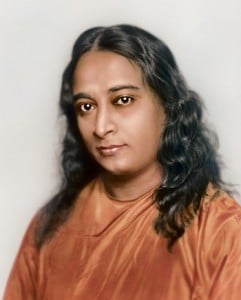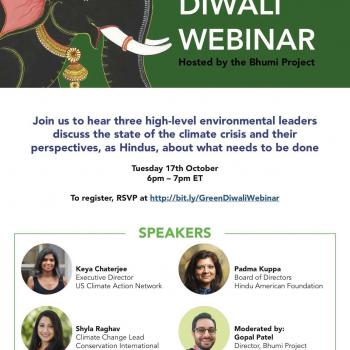The recent vote by the Senate to confirm Betsy Devos as Secretary of Education bothered me – and not just because I felt she is grossly unqualified for the job. It reminded me that we are in a state of polarization, in partisan or left/right silos, where social media enables us to hear only voices that amplify our feelings. Fear of the “other side” is festered, along with an inability to achieve balance or promote pluralism. To find that equanimity, I realized that I needed not only to unplug from technology and the world, but to withdraw into myself, and to practice meditation.
Hindus are not the first or only people of faith to encourage meditation and reflection; but it is the Hindu concept of self-realization, with the goal of merging one’s self into the [Divine] Self, that I am most familiar with. Whether identified through Greek words id, ego and superego, or Sanskrit words jivatma, atma and paramatma, human consciousness has multiple layers that we must penetrate to get to the Divine as part of our spiritual growth. The mind can be considered dual in nature – with one lower and one higher, which are sometimes at odds with one another. Through mindfulness, we can merge the wisdom of the higher mind with the rationality of the lower mind, to reach enlightenment.

As Paramahansa Yogananda, a great Hindu monk, said, “Self-realization is yoga, or “oneness” with truth — the direct perception or experience of truth by the all-knowing intuitive faculty of the soul.” Paramahansa Yogananda, founder of the Self Realization Fellowship, was born Mukunda Lal Ghosh in 1893, to an affluent Indian family. He became a monk in 1915, gave many lectures and taught people how to attain “direct personal experience of God” and eventually wrote his life story, The Autobiography of a Yogi. According to American Veda author Phil Goldberg, “Published just after World War II, this book remains the most influential memoir of a genuine master of the Vedic tradition ever written. It still inspires tens of thousands of new readers every year. “But Yogananda’s legacy extends beyond that iconic book. He arrived in 1920 and made America his home, establishing the world headquarters of his Self-Realization Fellowship (SRF) in Los Angeles, “the Benares of America.” For the next 32 years, his universal spiritual teachings and his Kriya Yoga practices reached millions.”
Paramahansa Yogananda’s description of Kriya Yoga is in his autobiography. According to the Self Realization Fellowship website:
The actual technique is given to students of the Self-Realization Fellowship Lessons after a preliminary period of study and practice of the three preparatory techniques taught by Paramahansa Yogananda.
Taken together as a comprehensive system, these meditation techniques enable the practitioner to achieve the highest benefits and divine goal of the ancient yoga science.
Decades later, another Hindu guru, Maharishi Mahesh Yogi, also came to the West, and brought with him another path to enlightenment: Transcendental Meditation, or its popular short form “TM.” Mahesh Yogi, who arrived in America right before the cultural and political revolution of the 1960s, said:
The goal of the Transcendental Meditation technique is the state of enlightenment. This means we experience that inner calmness, that quiet state of least excitation, even when we are dynamically busy…. we have a natural and effective means to dissolve even deeply rooted fatigue and stress. This is the way to unfold full value of life.
Even in the first days of meditation we find that our eyes seem to be a little more open, our mind seems a bit more clear. Our feeling towards our friends seems to be more harmonious.
And then, as the practice continues every day, a time will come when we will start living life free from all stresses. We cleanse the awareness of all stresses and strains, leaving the conscious mind completely free in its pure value.
However, I found my path to meditation through the Bhagavad Gita: Chapter 6 is fully focused on Krishna’s explanation of Dhyana Yoga, or the yoga of meditation. And so I turned to the translation of the Gita that my father gave me when I started college, by Swami Swarupananda of the Advaita Ashrama. In Chapter 6 – The Way of Meditation, verses 20-23 provided the essence of what I need to practice.
When the mind, absolutely restrained by the practice of concentration, attains quietude, and when seeing the Self by the self, one is satisfied in his own Self; when he feels that infinite bliss which is perceived by the (purified) intellect and which transcends the senses, and established wherein he never departs from his real state; and having obtained which, regards no other acquisition superior to that, and where established, he is not moved even by heavy sorrow; let that be known as the state, called by the name of Yoga – estate of severance from the contact of pain. This Yoga should be practiced with perseverance undisturbed by depression of heart.
Just as a good night’s sleep, a nutritious meal or a good workout can benefit your mind and body, a good meditation practice can also provide a good foundation to counter life’s daily challenges. It is something I have had to practice – sitting down and emptying your mind of all the day’s stressors does not happen at the flip of a switch. Rather, it is something that happens over time, with persistance – and sometimes it takes a little longer to get to that space where you are free from pressure. The benefit? Being able to come back to deal with the news of the day, however depressing, and react and respond from that place of equanimity. And through sadhana, a more sustained, deeper meditation practice? The hope is to reach a state of bliss, of self-realization.















